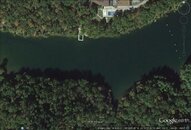so put a brick on each corner of the area, with an upline to a full size buoy, have a large dive flag on the dock, and make it clear that if the dive flag is up on the platform, then the boats have to stay on the *in this map* south side of the buoys. The issue you are going to have to figure out is that in order to make this a workable training area you have to have a means of controlled ascent and descent to at least one of the platforms for new students. This obviously has to be a big enough buoy so boats don't run into it. We use 8" PVC pipes which sit up quite tall and with SOLAS tape on it are visible at night.
You then have an issue with navigation of with their waypoints you now have to have catching features to keep them within that 10 acre area. That can be high viz polypro twisted line making a "fence" from the bricks holding the corner buoys back to the shore, or some other means of catching the divers. Other issue with waypoints is if you have uplines from each of the objects, you have to make the buoys big enough which make make the state grumpy because it impedes boat traffic. If you don't put buoys up, you now have to provide the bearings which takes parts of the skill out of it which is fine, just understand the limitations. You still need some sort of object to make sure that the divers are starting and leaving from the right spot. You can justify things like sunken cars and buses to the state by indicating that it will provide safe haven to encourage wildlife breeding and what not, which is true.
Advantage to a bus is it offers a HUGE learning opportunity for students. If you set the bus so it is perpendicular to the direction of travel, if the dive team is diving in proper navigation configuration *right diver as leader working with the compass, left diver with right hand on right divers left tricep monitoring depth and air*, then the dive team will tend to miss to the right. If you have them navigate to the left side of the bus, they will then have very good input based on where in the bus they hit as to their actual navigation accuracy.
Regarding fishermen, they are right. The fish will smarten up and realize that divers don't kill them, so they'll move into that area and be less available

 Here is a view of the entire area. The white buoys are on the end toward the rest of the lake. The area to the Left of the pic is a dead end with water that goes to only a couple feet. I'm putting in a few underwater markers on the buoy down lines to help mark the area underwater.
Here is a view of the entire area. The white buoys are on the end toward the rest of the lake. The area to the Left of the pic is a dead end with water that goes to only a couple feet. I'm putting in a few underwater markers on the buoy down lines to help mark the area underwater. 